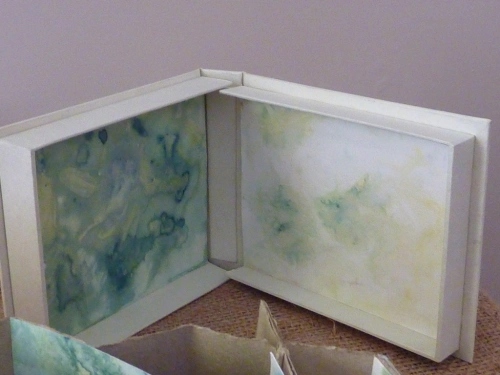The “iris green” of the Renaissance palette would have captured these shades of green in the landscape overlooking the Ottawa River at Portage-du-Fort, an area on the early 1600's exploration routes of Samuel de Champlain. The Stone School Gallery of the Pontiac School of the Arts marks the 400th anniversary of de Champlain's voyages in the region with a workshop in making and using Renaissance pigments and an exhibit of work by students and instructors.
My contribution post-workshop was a small selection of iris prints on paper and textile together with an Artist Book that documents the making of iris green pigment and the processes for obtaining contact dye prints with plants, in this case, the Tall Bearded Blue Iris. Renaissance artists would likely have had access to Iris pallida and Iris germanica, ancestors of the iris introduced to North America by early settlers and now a heritage variety in the gardens of Eastern Canada. This plant with striking blue flowers gave artists green for their palettes. The wild Iris versicolor (perhaps an escapee from pioneer gardens) is now the provincial flower of Quebec whose flag bears the image of the Fleur de Lys – a lily in name, an iris by form!
With these ideas in mind, and artistic license in action, the covers of my Artist Book show a green Fleur de Lys; the accordion spine (Saint Armand, Montreal “Canal” paper) is painted green with iris ink
Here are examples of fold-out text pages and pocket pages:
The green clothlet (R) soaked in iris pigment: blue iris pigment turns to green in the presence of alum in the cloth. The blue-purple pigment in iris is an anthocyanin identified as delphinidin or delphinin. The blues and purples (L) are on paper that has not been treated with alum. The yellows come from the anthers of the iris blooms as well as being components of the pigments that separate out into analagous colours in the steaming process.
Then overall book structure:
The Clamshell Case made by Shlomo with my eco printed and dyed papers (book inside)
The open Clamshell:
Three Iris prints:
The Iris Scroll (vintage silk, eco dye-printed and hand embroidered: iris-dyed strings). Another little pun: Hanging the textile perpendicular the wall installs it as if it were a flag:
This close-up invites you to find the Fleur de Lys on the “flag”:
The Iris book:
One of the other artists, Rob HInchley, led students in watercolour painting sessions by the river. Rob is a highly accomplished and adventurous printer, also. For this exhibit, he also shows HUGE prints made from his woodcuts on plywood sheets and printed with ink by a STEAMROLLER!!!
Rob carved whispering pines in the plywood. He read that de Champlain had written about the pines in his journals…small wonder. In those days, the 100 foot trees of the old forests would have been an unforgettable sight.
Rob's woodcut prints by steamroller:
The carved plate:
Pretty awesome art by Rob.
The marks made by the wood cuts really do convey the soft whispers of wind in pine branches…you can almost smell the pine wood and resin…striking effects in a hard medium and huge scale.
A la prochaine!
Wendy

















Green never looked so good! Your punning is fabulous, so many levels, love a good word play
I like those greens, too. They are not that easy to come by in natural dyes, never mind so many all at once from one flower. I will definitely try the iris again even if I have to use florist iris!
Pretty awesome work by you as well. Love the book and the puns
Thanks, Deborah. Hope the Cotswolds are producing wonderful blooms for you to try, also
w
oh. my. word! spectacular work ~ a feast for the eyes and heart with delicious word-smithing as well!
Thank you, Lace Lady!